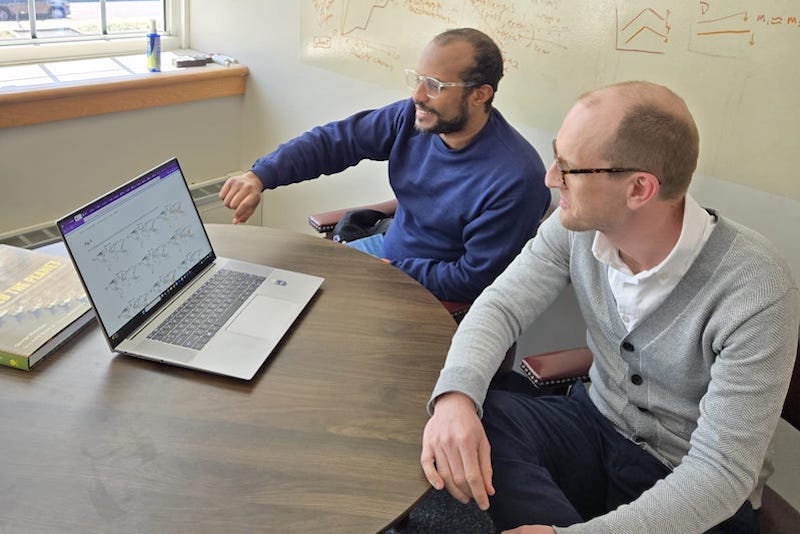


Global crop data
Photo courtesy of Endalkachew Kebede May 19, 2025
UD researcher creates new dataset to examine 21st century global crop dynamics
Efficient water usage in agriculture is crucial for sustaining a growing human population. A better understanding of the systems that support agriculture, farmers and farmlands allows for food production to become more efficient and prosperous.
That's what makes the Monthly Irrigated and Rainfed Cropped Areas Open Source (MIRCA-OS) dataset so important. MIRCA-OS offers high-resolution data on 23 crop classes — including maize, rice and wheat — and helps researchers, students and farmers examine irrigation, rainfall and croplands and how they interact with global water systems.
Co-authored by Endalkachew (Endi) Kebede, a doctoral student in University of Delaware’s Department of Geography and Spatial Sciences, a recent paper focused on MIRCA-OS was published in Nature Scientific Data.
Kyle Davis, assistant professor in the Department of Geography and Spatial Sciences and the Department of Plant and Soil Sciences, served as a co-author on the paper and coordinated the study.
“We first developed a comprehensive data library of crop-specific irrigated and rainfed harvested areas for all countries,” Kebede said. “This involved two years of gathering data from a wide range of international, national and regional sources. Through this process, we produced a tabulated crop calendar, annual harvested area grids and monthly harvested area grids for all irrigated and rainfed crops.”
“The amount of effort that Endi put in to gather, process and harmonize all of this data is truly incredible,” Davis said. “His effort is a very important contribution to the scientific and development communities.”
Cropland accounts for 13% of Earth's total habitable land, and the preservation of cropland is important in feeding the growing global population.
“Crop production has been a widespread human activity for a few thousand years, and it has a huge role in global food security,” Kebede said. “But it also has unintended impacts on the environment, such as overutilization of water resources, pollution through rivers or the effects on soil and the environment.”
MIRCA-OS can play a crucial role in helping to better understand croplands and agriculture, allowing the global population to be successfully fed while minimizing the agricultural effects on the environment.
In addition to the data included on cropland and water resources, MIRCA-OS allows researchers to view social aspects like poverty and unemployment through an agricultural lens, creating a better understanding of the interconnectivity of agriculture and social issues.
MIRCA-OS is an updated version of the earlier MIRCA2000 dataset. Kebede said the MIRCA2000 was released nearly two decades ago, so renewing the data gives users more accurate and timely information.
Both datasets specialized in examining irrigation and rainfall, but the MIRCA-OS added two new complexities to their data.
First, MIRCA-OS is open source, meaning it is publicly available for anyone to use, download, or modify. Kebede said the added accessibility allows the technology to contribute to anyone's work, whether it be a student, a researcher or a farmer.
“Anybody can use, update it, or upscale it to the special skill they’re interested in,” Kebede said. “Some might use it for research, some might use it to create policies and some might use it to practice agriculture.”
The second specialization of MIRCA-OS is its inclusion of irrigation and rainfall throughout several years. Unlike the MIRCA2000, which only contains data from the year 2000, MIRCA-OS looks at data from 2000-2015.
“This gives us an opportunity to see how irrigation and rainfall evolve over time,” Kebede said. “That can be used to study how water scarcity, water utilization, or water resource management evolves through time at both the local and global scale.”
Kebede said the dataset is expected to have a significant scientific and societal impact. By enabling fine-scale analysis of global cropping patterns, MIRCA-OS will support advances in climate adaptation, agricultural planning and water management. The dataset will offer valuable insights for researchers, policymakers and practitioners working at the intersection of food, water and climate systems.
“The more accurately we can represent cropping patterns across the planet, the more effectively we can promote scientific advances and real progress on global food security, sustainable agriculture and climate adaptation,” Davis said.
Contact Us
Have a UDaily story idea?
Contact us at ocm@udel.edu
Members of the press
Contact us at mediarelations@udel.edu or visit the Media Relations website

